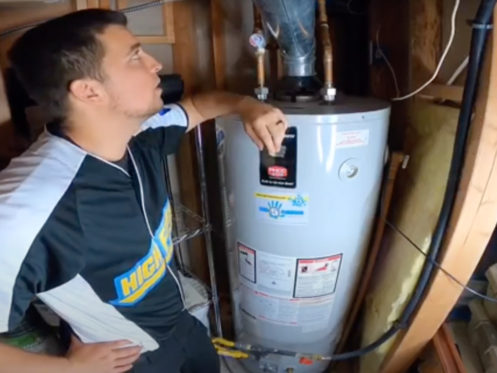Right here further down you might get additional incredibly good tips all about Water Heater Maintenance Tips You Can't Afford to Forget.

Warm water is crucial for everyday convenience, whether it's for a refreshing shower or cleaning dishes. To guarantee your hot water system runs successfully and lasts much longer, regular upkeep is key. This post provides practical suggestions and understandings on just how to keep your home's hot water system to avoid interruptions and pricey repairs.
Introduction
Preserving your home's warm water system could appear challenging, but with a few basic actions, you can guarantee it operates smoothly for many years to find. This overview covers every little thing from recognizing your hot water system to DIY maintenance suggestions and understanding when to employ expert aid.
Relevance of Keeping Your Warm Water System
Regular maintenance not only extends the life-span of your warm water system yet also ensures it runs effectively. Ignoring upkeep can bring about lowered performance, greater power expenses, and also early failure of the system.
Indications Your Hot Water System Needs Maintenance
Understanding when your warm water system requires focus can prevent major issues. Watch out for indications such as irregular water temperature level, weird noises from the heater, or rustic water.
Comprehending Your Warm Water System
Prior to diving right into upkeep jobs, it's handy to understand the basic components of your hot water system. Generally, this includes the water heater itself, pipes, anode poles, and temperature level controls.
Month-to-month Upkeep Tasks
Routine monthly checks can help capture small problems before they escalate.
Purging the Hot Water Heater
Flushing your water heater removes debris accumulation, boosting performance and extending its life.
Monitoring and Replacing Anode Rods
Anode rods avoid rust inside the tank. Examining and replacing them when worn out is critical.
Checking and Changing Temperature Setups
Changing the temperature setups makes sure optimal performance and safety and security.
DIY Tips for Maintenance
You can do a number of maintenance jobs yourself to maintain your hot water system in leading condition.
Looking for Leakages
Routinely evaluate pipelines and connections for leakages, as these can result in water damages and greater bills.
Examining Pressure Alleviation Valves
Checking the pressure safety valve ensures it works appropriately and avoids too much pressure build-up.
Protecting Pipelines
Protecting hot water pipelines reduces warm loss and can save power.
When to Call a Professional
While do it yourself maintenance is helpful, some issues call for specialist competence.
Complex Concerns Needing Professional Aid
Examples consist of significant leaks, electrical troubles, or if your water heater is continually underperforming.
Routine Expert Upkeep Advantages
Expert maintenance can include detailed inspections, tune-ups, and guaranteeing compliance with safety and security standards.
Final thought
Normal maintenance of your home's warm water system is essential for effectiveness, long life, and cost savings. By complying with these pointers and knowing when to look for specialist help, you can guarantee a trusted supply of hot water without unforeseen interruptions.
Water Heater Maintenance Tips
Test the TPR Valve
- Shut off the power and the cold-water supply valve.
- Place a bucket under the pipe connected to the temperature-pressure-release (TPR) valve on the top or side of the tank. (This valve opens if the tank pressure gets too high.)
- Lift the valve’s tab to let some water out, then let go. If water keeps flowing, drain the tank partway, unscrew the old valve with a pipe wrench, and install a new one.
Check the Anode Rod
- Put a hose to the tank’s drain cock and let out a few gallons of water.
- Now fit a 1 1/16-inch socket onto the rod’s hex head on top of the heater (or under its top plate) and unscrew the rod. If it’s less than ½ inch thick or coated with calcium, buy a new one, wrap its threads with Teflon tape, put it back in the tank, and tighten securely. Use this segmented rod if headroom above the tank is limited.
Drain the Tank and Wash Out Sediment
- Drain the remaining water in the tank into the bucket, then stir up the sediment on the tank’s bottom by briefly opening the cold-water supply valve. Drain and repeat until clean water comes out of the hose.
- Close the drain cock, refill the tank, and turn its power back on.
Adjust the Temperature
- Find the temperature dial on the side of the tank and unscrew its cover. Adjust the dial to 120 degrees using a flathead screwdriver. For every 10 degrees the temperature is lowered, you can expect to save up to 5 percent in energy costs.
- Turn the water heater off or the thermostat down to its lowest setting if you plan to be away from home for more than three days.
Insulate the Pipes
- Buy some self-sticking 3/8-inch-thick foam pipe insulation that matches the pipes’ diameter.
- Slide the foam over the hot-and cold-water pipes as far as you can reach. Insulating the cold-water pipe prevents condensation in summer.
- Peel the tape and squeeze the insulation closed. If the pipe is 6 inches or less from the flue, cover it with 1-inch-thick unfaced fiberglass pipe wrap.
https://www.thisoldhouse.com/plumbing/21016402/how-to-maintain-a-water-heater

As an enthusiastic reader on What Kind of Maintenance Do Water Heaters Need?, I imagined sharing that chunk was a good thing. Sharing is caring. You never know, you may be helping someone out. We value reading our article about How to Maintain Your Water Heater & Prolong its Life.
Get A Free Estimate
Comments on “Important Advice on Maintaining Your Home's Hot Water System”